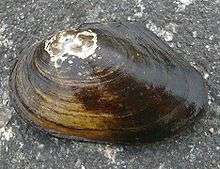Palaeoheterodonta
| Palaeoheterodonta | |
|---|---|
 | |
| Anodonta anatina | |
| Scientific classification | |
| Kingdom: | Animalia |
| Phylum: | Mollusca |
| Class: | Bivalvia |
| Subclass: | Palaeoheterodonta |
| Orders | |
Palaeoheterodonta is a subclass of bivalve molluscs.[1] It contains the extant orders Unionoida (freshwater mussels) and Trigonioida. They are distinguished by having the two halves of the shell be of equal size and shape, but by having the hinge teeth be in a single row, rather than separated into two groups, as they are in the clams and cockles.[2]
2010 Taxonomy of the Palaeoheterodonta
In 2010 a new proposed classification system for the Bivalvia was published in by Bieler, Carter & Coan revising the classification of the Bivalvia, including the subclass Paleoheterodonta.[3] Superfamilies and families as listed by Bieler et al. Use of † indicate families and superfamilies that are extinct.
Subclass: Palaeoheterodonta
Order: Trigoniida[4]
- †Beichuanioidea Liu & Gu, 1988
- †Beichuaniidae Liu & Gu, 1988
- †Megatrigonioidea Van Hoepen, 1929
- †Megatrigoniidae Van Hoepen, 1929
- †Iotrigoniidae Savelive, 1958
- †Rutitrigoniidae Van Hoepen, 1929
- †Myophorelloidea Kobayashi, 1954
- †Myophorellidae Kobayashi, 1954
- †Buchotrigoniidae Leanza, 1993</small
- †Laevitrigoniidae Savelive, 1958
- †Vaugoniidae Kobayashi, 1954
- Trigonioidea Lamarck, 1819
- Trigoniidae Lamarck, 1819
- †Eoschizodidae Newell & Boyd, 1975 (syn: Curtonotidae)
- †Groeberellidae Pérez, Reyes, & Danborenea 1995
- †Myophoriidae Bronn, 1849 (syn: Cytherodontidae, Costatoriidae, Gruenewaldiidae)
- †Prosogyrotrigoniidae Kobayashi, 1954
- †Scaphellinidae Newell & Ciriacks, 1962
- †Schizodidae Newell & Boyd, 1975
- †Sinodoridae Pojeta & Zhang, 1984
Order: Unionoida[5]
- Superfamily †Archanodontoidea Modell, 1957 (placement in Unionoida uncertain)
- Family †Archanodontidae Modell, 1957
- Superfamily Etherioidea Deshayes, 1832
- Family Etheriidae Deshayes, 1832 (syn: Mulleriidae, Pseudomulleriidae)
- Family Iridinidae Swainson, 1840 (syn: Mutelidae, Pleiodontidae)
- Family Mycetopodidae Gray, 1840
- Superfamily Hyrioidea Swainson, 1840
- Superfamily †Trigonioidoidea Cox, 1952
- Family †Trigonioididae Cox, 1952
- Family †Jilinoconchidae Ma, 1989 (placement uncertain)
- Family †Nakamuranaiadidae Guo, 1981 (syn:Sinonaiinae, Nippononaiidae)
- Family †Plicatounionidae Chen, 1988
- Family †Pseudohyriidae Kobayashi, 1968
- Family †Sainschandiidae Kolesnikov, 1977
- Superfamily Unionoidea Rafinesque, 1820
- Family Unionidae Rafinesque, 1820
- Family Liaoningiidae Yu & Dong, 1993 (placement uncertain)
- Family Margaritiferidae Henderson, 1929 (syn:Margaritaninae, Cumberlandiinae, Promargaritiferidae)
- Family †Sancticarolitidae Simone & Mezzalira, 1997
References
- ↑ Palaeoheterodonta Newell, 1965. Retrieved through: World Register of Marine Species on 9 July 2010.
- ↑ Barnes, Robert D. (1982). Invertebrate Zoology. Philadelphia, PA: Holt-Saunders International. p. 340. ISBN 0-03-056747-5.
- ↑ Bieler, R., Carter, J.G. & Coan, E.V. (2010) Classification of Bivalve families. Pp. 113-133, in: Bouchet, P. & Rocroi, J.P. (2010), Nomenclator of Bivalve Families. Malacologia 52(2): 1-184
- ↑ Trigonioida Newell, 1965. Retrieved through: World Register of Marine Species on 3 February 2009.
- ↑ Unionoida Stoliczka, 1871. Retrieved through: World Register of Marine Species on 3 February 2009.
This article is issued from
Wikipedia.
The text is licensed under Creative Commons - Attribution - Sharealike.
Additional terms may apply for the media files.